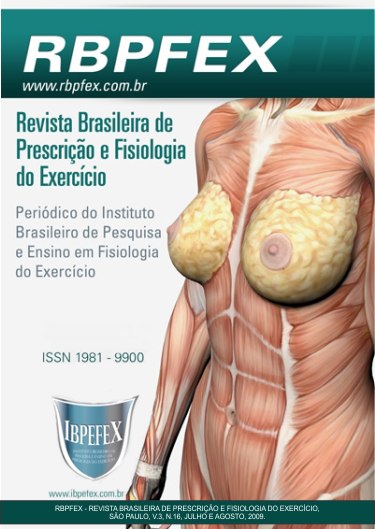The acute effect on blood pressure in water gym men normtenses
Abstract
Introduction: Hypotension after-exercise is characterized for the reduction of the arterial pressure during the period of recovery, making with that the pressure values observed after-exercises remain inferior to those measured before the exercise or same those measured in one day has controlled, without the execution of exercises. Objective: to verify the acute effect of a program of exercise in water in the arterial pressure (5, 10, 15, 30, 45 e 60 minutes after exercise) in normtenses men. Methodology: the sample was composed for 24 individuals of the masculine sex divided in 2 groups, being the first group experimental (GE; n= 12; 26.6±3.2 years; 24.4±2.6 kg/m2) and as the group has controlled (GC; n= 12; 25.6±3.0 years; 23.6±2.1 kg/m2). They had been carried through only one visit where it was collected given anthropometrics and GE was submitted the 1 session 40 minutes of exercise in water between 56 and 70% of the cardiac frequency of reserve, the GC met in rest in the water during this determined time. The pressure was surveyed by means of the auscultator method, using sphygmomanometer aneroid (Tycos®) and stethoscope (Sprague®) the descriptive statistics was composed for the averages, shunting line standard and for the inferential analysis was used ANOVA for measures repeated with verification post-hoc of Turkey (p<0.05).Results: the results of the present study show significant reduction (p<0.05) of the arterial pressure in the experimental group. Conclusion: the results of the present study show to significant reduction (p<0.05) of the arterial pressure in the group exercise. Conclusion: the Hydrogymnastic is capable to generate hypotension after exercise.
References
- Alves, R.V.; Mota, J.; Costa, M.C.; Alves, J.G.B. Aptidão física relacionada à saúde de idosos: influência da hidroginástica. Rev Bras Med Esporte. Vol. 10. Num. 1. 2004. p. 31-37.
- Araújo, C.G.S. Fisiologia do exercício físico e hipertensão arterial: Uma breve introdução. Revista Hipertensão. Vol. 4. Num. 3. 2001. p. 78-83.
- Black, J.M.; Matassarin-Jacobs, E.; Luckmann; Sorensen. Enfermagem médico-cirúrgica: uma abordagem psicofisiológica. 4aed. Rio de Janeiro. Guanabara. 1996.
- Brum, P.C.; Forjaz, C.L.M.; Tinucci, T.; Negrão, C.E. Adaptações agudas e crônicas do exercício físico no sistema cardiovascular. Rev. paul. Educ. Fís., São Paulo, Vol. 18. 2004. p. 21-31.
- Caromano, F.A.; Themudo, M.R.; Candeloro, J.M. Efeitos Fisiológicos da imersão e do exercício na água. Revista Fisioterapia Brasil. Vol. 4. Num. 1. 2003. p. 60-65.
- Cunha, G.A.; e colaboradores. Hipotensão pós-exercício em hipertensos submetidos ao exercício aeróbio de intensidades variadas e exercício de intensidade constante. Rev Bras Med Esporte. Vol. 12. Num. 6. 2006. p. 313-317.
- Forjaz, C.L.M.; e colaboradores. A duração do exercício determina a magnitude e a duração da hipotensão pós-exercício. Arq. Bras. Cardiol., São Paulo. Vol. 70. Num. 2. 1998. p. 99-104.
- Mediano, M.F.F.; Paravidino, V.; Simão, R; Pontes, F.L.; Polito, M.D. Comportamento subagudo da pressão arterial após o treinamento de força em hipertensos controlados. Rev Bras Med Esporte, Vol. 11, Num. 6. 2005. p. 337-340
- Monteiro, M.F.; Sobral Filho, D.C. Exercício Físico e o controle da pressão arterial. Revista Brasileira de Medicina do Esporte, vol. 10, Num. 6. 2004. p. 513-514.
- Nunes, A.P.O.B.; e colaboradores. The effects of nonsupervised exercise program, via internet, on blood pressure and body composition in normotensive and pré-hipertensive individuals. Arq. Bras. Cardiol., São Paulo. Vol. 86. Num. 2006. 4, p. 289-296.
- Polito, M.D.; Simão, R.; Senna, G.W.; e colaboradores. Efeito hipotensivo do exercício de força realizado em intensidades diferentes e mesmo volume de trabalho. Revista Brasileira de Medicina do Esporte, Vol. 9. Num. 2. 2003. p. 69-73.
- Rebelo, F.P.V.; Benetti, M.; Carvalho, T. Efeito agudo do exercício físico aeróbio sobre a pressão arterial de hipertensos controlados submetidos a diferentes volumes de treinamento. Revista Brasileira de Atividade Física e Saúde. Vol. 6. Num. 2. 2001. p. 28-38.
- Scartoni, F. R.; Dantas, E.H.M.; Dantas, B. H.A. A influência dos diversos tipos de estratégia, utilizados nas aulas de hidroginástica nos parâmetros fisiológicos do praticante. Fitness e Performance journal, Rio de Janeiro, Vol. 1. Num. 2. 2002. p. 52-59.
- Teixeira, J.A.C. Hipertensão arterial sistêmica e Atividade Física. Revista SOCERJ. Vol. 13. Num. 4. 2000. p. 25-30.
- Colégio Americano de Medicina Esportiva: Exercise for Patient with Coronary Artery Disease. Revista Med. Sci. Sports Exerc., Vol. 26, Num. 3, 1994. p. 1-5.
Authors who publish in this journal agree to the following terms:
- Authors retain the copyright and grant the journal the right of first publication, with work simultaneously licensed under the Creative Commons Attribution License BY-NC which allows the sharing of the work with acknowledgment of the authorship of the work and initial publication in this journal.
- Authors are authorized to enter into additional contracts separately for non-exclusive distribution of the version of the work published in this journal (eg, publishing in institutional repository or book chapter), with acknowledgment of authorship and initial publication in this journal.
- Authors are allowed and encouraged to post and distribute their work online (eg, in institutional repositories or on their personal page) at any point before or during the editorial process, as this can bring about productive change as well as increase impact and impact. citation of published work (See The Effect of Free Access).






